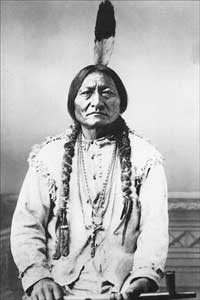Sioux
Native American and First Nations ethnic groups / From Wikipedia, the free encyclopedia
Dear Wikiwand AI, let's keep it short by simply answering these key questions:
Can you list the top facts and stats about Sioux?
Summarize this article for a 10 year old
The Sioux or Oceti Sakowin (/suː/ SOO; Dakota/Lakota: Očhéthi Šakówiŋ /oˈtʃʰeːtʰi ʃaˈkoːwĩ/) are groups of Native American tribes and First Nations people from the Great Plains of North America. The Sioux have two major linguistic divisions: the Dakota and Lakota peoples (translation: "friend" or "ally" referring to the alliances between the bands). Collectively, they are the Očhéthi Šakówiŋ, or "Seven Council Fires". The term "Sioux", an exonym from a French transcription ("Nadouessioux") of the Ojibwe term "Nadowessi", can refer to any ethnic group within the Great Sioux Nation or to any of the nation's many language dialects.
Očhéthi Šakówiŋ | |
|---|---|
 | |
| Total population | |
| 170,110 (2010)[1] | |
| Regions with significant populations | |
| United States: (South Dakota, Minnesota, Nebraska, Montana, North Dakota, Iowa, Wisconsin, Illinois, Wyoming) Canada: (Manitoba, Saskatchewan) | |
| Languages | |
| Sioux language (Lakota, Western Dakota, Eastern Dakota), English | |
| Religion | |
| Wocekiye, Christianity (incl. syncretistic forms), traditional religion | |
| Related ethnic groups | |
| Assiniboine, Dakota, Lakota, Nakoda (Stoney), and other Siouan-speaking peoples |
Before the 17th century, the Santee Dakota (Isáŋyathi; "Knife" also known as the Eastern Dakota) lived around Lake Superior with territories in present-day northern Minnesota and Wisconsin. They gathered wild rice, hunted woodland animals and used canoes to fish. Wars with the Ojibwe throughout the 18th century pushed the Dakota west into southern Minnesota, where the Western Dakota (Yankton, Yanktonai) and Lakota (Teton) lived. In the 19th century, the Dakota signed land cession treaties with the United States for much of their Minnesota lands. The United States failure to make treaty payments or provide rations on time led to starvation and the Dakota War of 1862, which resulted in the Dakota's exile from Minnesota. They were forced onto reservations in Nebraska, North Dakota, and South Dakota, while some fled to Canada. After 1870, the Dakota people began to return to Minnesota, creating the present-day reservations in the state. The Yankton and Yanktonai Dakota (Iháŋktȟuŋwaŋ and Iháŋktȟuŋwaŋna; "Village-at-the-end" and "Little village-at-the-end"), collectively also referred to by the endonym Wičhíyena, lived near Minnesota River before ceding their land and moving to South Dakota in 1858. Despite ceding their lands, their treaty with the U.S. government allowed them to maintain their traditional role in the Očhéthi Šakówiŋ as the caretakers of the Pipestone Quarry, a cultural center for Sioux people. Considered to be the Western Dakota, they have in the past been erroneously classified as Nakota.[2] Nakota are the Assiniboine and Stoney of Western Canada and Montana.
The Lakota, also called Teton (Thítȟuŋwaŋ; possibly "dwellers on the prairie"), are the westernmost Sioux, known for their Plains Indians hunting and warrior culture. With the arrival of the horse in the 18th century, the Lakota become a powerful tribe on the Northern Plains by the 1850s. They fought the U.S. Army in the Sioux Wars including defeating the 7th Cavalry Regiment at the Battle of Little Big Horn. The armed conflicts with the U.S. ended with the Wounded Knee Massacre.
Throughout the 20th and 21st centuries, the Dakota and Lakota continued to fight for their treaty rights, including the Wounded Knee incident, Dakota Access Pipeline protests and the 1980 Supreme Court case, United States v. Sioux Nation of Indians, in which the court ruled that tribal lands covered under the Fort Laramie Treaty of 1868 had been taken illegally by the US government, and the tribe was owed compensation plus interest. As of 2018, this amounted to more than $1 billion; the Sioux have refused the payment, demanding instead the return of the Black Hills. Today, the Sioux maintain many separate tribal governments across several reservations and communities in North Dakota, South Dakota, Nebraska, Minnesota, and Montana in the United States; and reserves in Manitoba and Saskatchewan in Canada.